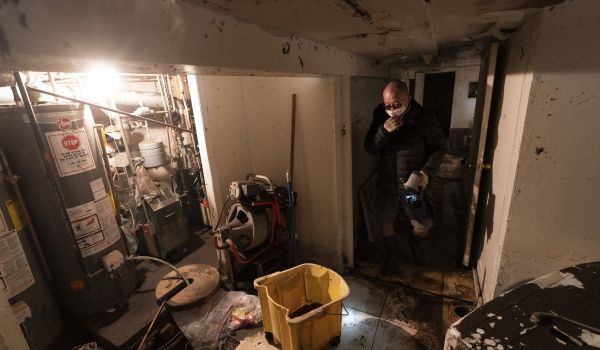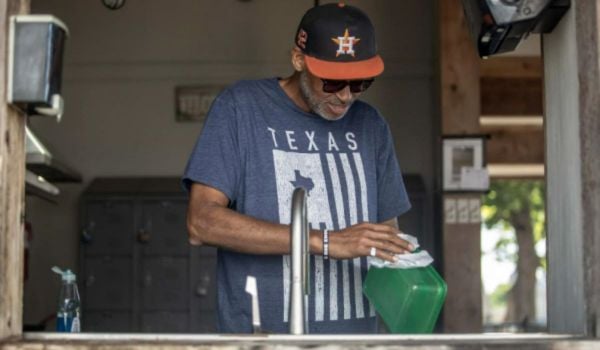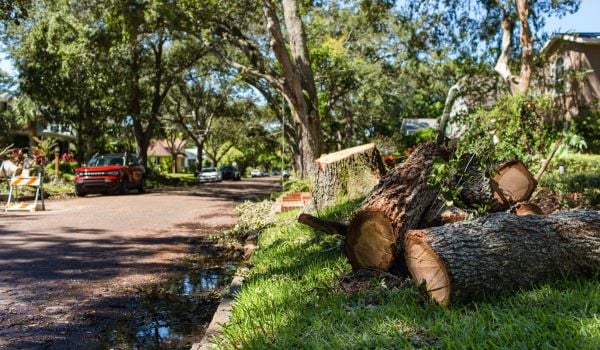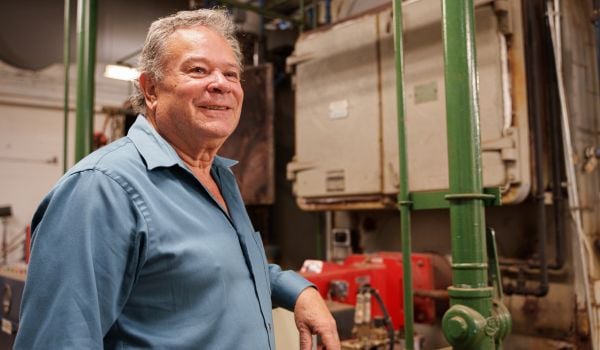This article by Yale Climate Connections is published here as part of the global journalism collaboration Covering Climate Now.
Beverly May, retired nurse practitioner and current epidemiologist at the University of Kentucky, lives maybe 100 feet from the house she grew up in Floyd County, Kentucky. She characterizes her community as “hillbilly country,” an area in central Appalachia that once served as a critical cog in the coal industry’s wheel. When historic floods ravaged the area in late July 2022, May decided to trade in her medical work for flood research and activism with the nonprofit community well-being organization Kentuckians for the Commonwealth.
“I’ve lived here all my life, and I could not believe it when I saw helicopters going out to rescue people,” she says. “Never has there been this many deaths.”
Summer 2022 was the season the sky fell. After months of drought in Texas, Louisiana, and Kentucky, storms dropped a month’s worth to a year’s worth of rain in a few hours, rocking the county with multiple 1-in-1000-year floods.
From Florida and Louisiana to Mississippi, and in Texas towns near the Gulf Coast and rural areas in Appalachia, people like May are banding together with their neighbors to deal with the effects of historic floods worsened by a warming climate. They’re demanding more help from government officials with recovery and better infrastructure for drainage and buffering floodwaters. The need will only grow more dire, as floods and other extreme weather events are projected to worsen in the coming decades. The U.S. Southeast, which is uniquely vulnerable to these disasters, is an area of intense organizing and activism.
Flooding “is happening everywhere, but the South is particularly vulnerable because we set the table of development in the worst places,” explains Sam Brody, director of the Institute for a Disaster Resilient Texas at Texas A&M University.
“One of the big problems we’re facing is that our infrastructure is aging, is not well maintained, and was built under capacity,” he says. “It’s even a problem in wealthy urban communities, but it’s more prominent in smaller under-resourced communities.”
Leveled Mountaintops, Rising Waters
May’s home, like most in the area, sits between creek beds and the rolling Appalachian hills. She grew up with spring floods, though nothing like this past summer.
In July 2022, valleys in about 13 east Kentucky counties filled with rushing water as creeks rose, wiping many small towns completely off the map. First responders rescued dozens of people from the rising floodwaters but hundreds more were trapped. The state calculated that 43 people died in the flooding. Over 1,600 people lost their homes.
“This flooding was six feet higher than 1957,” the last record-high floodwaters in the region, says Pam Meade of West Liberty in Morgan County, an artist, resident, and member of Kentuckians for the Commonwealth. She and May recalled that last summer, houses were turned into matchsticks, trailers were wrapped like tinfoil around trees, and the road asphalt was peeled back in multiple places from the flooding. Both of them were largely spared from the damage of the July flood, and both have been heavily involved in mutual aid and relief efforts designed to help the hundreds of people in Floyd and Knox Counties who have been homeless since the disaster.
Meade said that many residents “lived in places that had never flooded before. So of course they didn’t have flood insurance and FEMA has denied so many claims … it’s just been really hard for people.”
They pin part of the blame for the extensive flood damage on coal mining, especially mountaintop removal, a practice in which the top of a mountain is blown up for access to the coal underneath. That form of mining has left more residents vulnerable to severe floods.
An unmined valley will slow the flow of rainwater, May explains, while after mountaintop removal, “the land looks like a tabletop. It’s kind of like water running off of an asphalt parking lot. I wish I had a nickel for everybody that told me the water never got close to my house before [the mining] and then their house was destroyed.”
May’s research showcases the correlation between flood-related mortality and strip-mined mountains, and she says she’s been able to account for 35 out of the 43 reported deaths. “You can see very clearly that the proximity to mining and living on a holler that had been mined was deadly. People drowned because the water came down just way too fast,” she says. On Feb. 13, 2023, May and her team sent their flood fatality map and a letter requesting an investigation of the government’s failure to prevent regional flood deaths to U.S. Department of Interior Secretary Deb Haaland.
Hurricanes, Flooding, And Pollution
Along the Gulf of Mexico, communities in Texas, Louisiana, and Florida have become hotbeds for disasters linked to hurricanes, sea level rise, land loss, and severe flooding. In many cases, flooding events here have lost their seasonality; heavy rain is enough to cause significant damage, meaning communities have to be prepared for the worst at any time.
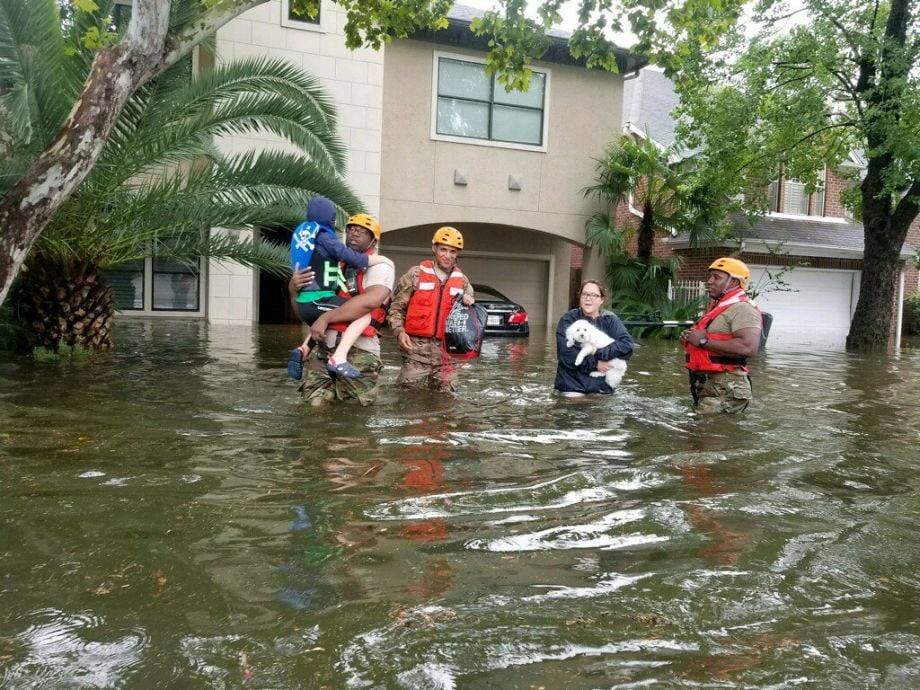
Texas National Guard soldiers arrive in Houston, Texas to aid citizens in heavily flooded areas from the storms of Hurricane Harvey. (Photo by Lt. Zachary West, 100th MPAD / CC BY-ND 2.0)
In some parts of Texas, these events combine with pollution from chemical facilities to leave streets filled with toxic and gasoline-filled waters. Houston native Rolando Perez has lived in his family home for over 45 years and has been flooded out five times. Perez decided to join the Northeast Action Collective to help support disaster relief efforts and combat environmental racism in Houston.
“These floods seem to be increasing more and more outside of the hurricane season,” Perez says. “I believe we have had 22 of these 1-in-100 year, 1-in-1000 year type of storms in the last seven years.”
Perez’s colleague Becky Selle, co-director of organizing, researching, and rebuilding for West Street Recovery, pointed out that Houston’s waste treatment systems have not been updated as the population has grown, which has added more raw sewage to floodwaters.
“Kids are standing in this water to go to school. There are massive health issues that we think are without a doubt tied to the massive street flooding,” Selle says.
Environmental Racism, Poor Infrastructure
Environmental racism has exacerbated the problems associated with flooding, says Robert Bullard, professor of urban planning and environmental policy at Texas Southern University.
Environmental racism occurs when environmental hazards, such as toxic Superfund sites, landfills, highways, and polluting industries, are — as a result of institutionalized discrimination – disproportionately located in or near predominantly Black and Brown communities.
“It’s projected that in the next 30 years, the kinds of damages seen from flooding will increase by 25%. For communities that have a disproportionate number of Black people, they will see a 40% increase,” says Bullard, often described as the father of environmental justice. The Government Accountability Office in 2019 found that wildfires and flooding threaten approximately 60% of Superfund sites in the U.S., many of them near public housing, poor neighborhoods, and Black and Brown communities.
Infrastructure is also often inadequate in flood-prone, predominantly Black and Brown communities in Houston and Harris County. As a result, Perez and Selle noted, their communities face a double whammy: more exposure to pollution from industries stoking climate change as well as more flooding damage.
They also pointed out that many low-income Houston neighborhoods rely on open-ditch drainage systems that are notorious for getting clogged with trash, litter, and other debris, and residents must make sure the drains work; the city does not maintain them. “I’m sure the wealthier neighborhoods are experiencing flooding too,” Perez says, “but they have better drainage systems.”
In May 2022, the Washington Post reported that Texas allocated zero dollars to flood-prone low-income and predominantly Black neighborhoods in Houston from the $1 billion in federal funding that the state received for preventing future disasters.
Farther south in the Rio Grande Valley along the Texas-Mexico border, organizers Emma Guevara with the Sierra Club and Patricia Rubio with Another Gulf is Possible noted the same trend in their Cameron County communities, on the southernmost tip of Texas.
“We have really poor infrastructure compared to a lot of the United States, and one of the main ways that really affects us is through really massive amounts of flooding,” Guevara says.
Environmental racism also affects people in Cameron County, a river delta on the Gulf of Mexico with a large Latino population that is home to small unincorporated housing developments called colonias. For years, Guevara and Rubio said, their communities have fought against the development of new natural gas facilities on one end and flooding on the other.
Rubio, Guevara, and other activists have their work cut out for them in trying to improve the situation. In 2017, Texas Gov. Greg Abbott vetoed a nearly $860,000 package that was slated for drinking water, waste management, and other infrastructure development for colonias in counties like Cameron. Rubio and Guevara noted that it took 30 years of asking before one colonias community could even get streetlights.
“I don’t feel that we’re a priority,” Rubio says.
A History Of Disinvestment
Many historically disinvested communities facing disasters never see funding from the federal initiatives aimed at them. After Hurricane Harvey in 2017, “there were only 800 homes in Houston repaired and over 100,000 flooded,” Selle says. Organizers say this is because federal infrastructure money often runs through revolving funds administered by sometimes biased state executives.
“Our elected officials have just really made it clear that they don’t have any interest in working with us,” Rubio says about the Rio Grande Valley region.
In Jackson, Mississippi, a predominantly Black community, heavy rains in August 2022 led to severe flooding along the Pearl River, and the main water treatment plant malfunctioned. Jackson was already under a boil water advisory, and the flooding exacerbated the drinking water issue. City infrastructure, largely neglected for decades, couldn’t handle the flooding.
“Jackson is a perfect example of a disaster that did not have to happen if there had been investment years ago in the water system, in the processing stations, in the pipes,” explains Tanya Gulliver-Garcia, director of learning and partnership at the Center for Disaster Philanthropy.
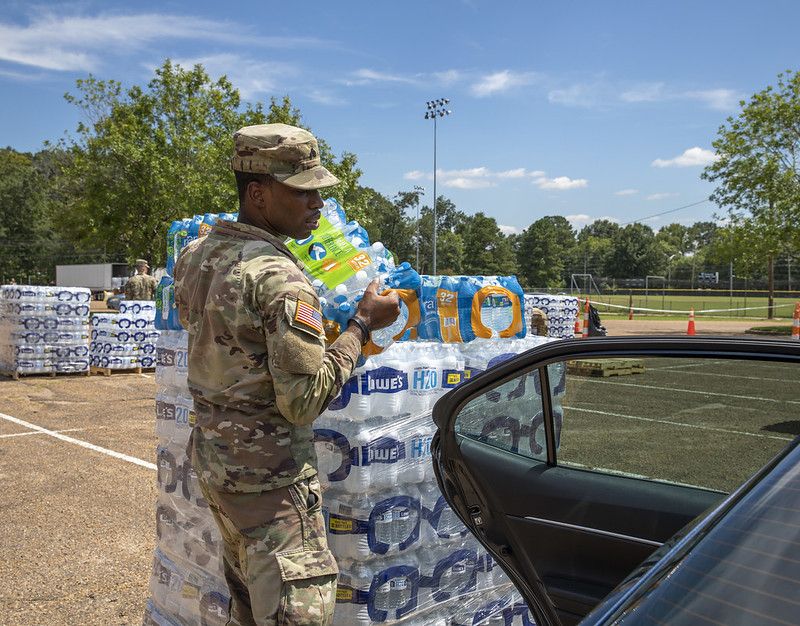
A soldier puts water in the backseat of a person's car during the Jackson water crisis. (Photo by Staff Sgt. Connie Jones / U.S. Army National Guard / CC BY 2.0)
“Jackson is the only city in the entire state that has to go through two different processes in order to get approval from American Rescue Plan funding,” notes Abre’ Conner, director of environmental and climate justice for the NAACP. “And when you have a governor who’s shown flagrant racism toward Jackson and its residents, that explains why the community has gone so long without infrastructure and relief funds.” She added that Mississippi’s state government has also set restrictions on federal funding allocations that disproportionately exclude the state’s majority Black state capital.
“Black communities … because of lack of infrastructure and historic discrimination, will see their communities inundated with floodwaters and other resource issues,” Bullard says. In December 2022, Jackson’s mayor declared another state of emergency and issued a new boil water advisory – this time in response to cold weather damage to the city’s water system.
Across the country, dwindling funding due to the media’s and the public’s short attention spans is another problem. Gulliver-Garcia said about 80% of funding for disasters comes in the first five days, with support fading when a new disaster hits another area.
“The majority of money over the years still goes into response and relief. We all need to be focusing on prevention and recovery in climate as well. And until we’re doing that, we’re not going to see a change and we’re just going to keep having disaster after disaster,” Gulliver-Garcia says.
Banding Together, Seeking Support
As climate-linked disasters keep hitting the same communities, activists hope they can band together to build strength — and support.
“We need to start looking not only at an economic equity lens but also … to show how racism in the past is making it more difficult for communities of color to access additional funding to deal with these crises,” Bullard says. After Hurricane Harvey, Selle’s group of community members developed West Street Recovery to help long-term flood recovery efforts and to serve as a support group for people hurt by flooding.
Selle said that even small steps — like planting trees or developing rain gardens to absorb rainfall — can help. “We should treat the land as the wetland that it originally was and try to like develop alongside that,” she says.
Guevara and Rubio noted that infrastructure development and climate adaptation need to be inclusive. This includes making disaster relief available to all regardless of citizenship status, and making sure information is disseminated in other languages for non-English speaking individuals.
“A lot of people are afraid to apply for any kind of benefits because they’re worried about their citizenship status. And there are so many people who suffer that didn’t need to because they’re so scared of how policed and how militarized our community is,” Guevara says.
In Kentucky, an unknown number of residents are still in tents and campers, relying on neighbors for food, shelter, and supplies. Meade said that several official distribution centers started shutting down in October; those that have remained have struggled through the cold months and are primarily individuals delivering supplies out of their homes.
But May has taken pride in her community’s resilience thus far.
“I cannot tell you the number of women I have run into who said, ‘As soon as the water went down, I got in my kitchen and started cooking.’ This must have been dozens and dozens of families who did this, who just started feeding their neighbors without anybody having to tell them. Because that’s who we are. That’s what hillbillies do. We take care of each other.”
How To Help
Flood recovery and infrastructure development efforts are ongoing. Many communities are still in need from storms or events that took place several years ago. The following is a list of organizations working on recovery efforts in the communities outlined in this article.
Kentucky
Appalshop — Appalshop was established as a War on Poverty project and has since become a hub for creativity, culture, multimedia storytelling, and cultural preservation in Eastern Kentucky. It has served as a point of great inspiration for artists like Pam Meade. Unfortunately, many of the works were damaged during the summer flooding. On Feb. 16, 2023, the Center for Rural Strategies and the Daily Yonder released a 30-minute documentary produced by the former executive director of Appalshop about the July floods — the damage and the mutual aid efforts.
Kentuckians for the Commonwealth — This collective of approximately 11 chapters across the state of Kentucky serves as a hub for mutual aid, voting advocacy, and generally for promoting the well-being of all people in the state.
Texas
West Street Recovery — This community collective was developed in 2017 after Hurricane Harvey by concerned citizens in Houston. They are now a horizontally structured nonprofit organization working to address disaster relief and provide mutual aid to those most affected by extreme weather events in Houston.
Mississippi
Mississippi Rapid Response Coalition — This collective of Mississippi Mutual Aid and nonprofit organizations was established at the beginning of the COVID-19 pandemic to support communities across the state that have been disproportionately affected by COVID, climate change, and infrastructure disinvestment. With the Jackson water crisis continuing, they are working to distribute fresh water to affected residents.
The Gulf of Mexico
Another Gulf is Possible — This is a small collective of individuals representing predominantly Black and Brown communities across the Gulf region. Their focus is on capacity-building and direct action centered in principles of transformative justice. Their membership represents Texas, Louisiana, and Mississippi.

Cameron Oglesby is a youth environmental justice advocate, oral historian, ecologist, consultant, and multimedia storyteller. Cameron is passionate about integrating community-centered, equity-oriented perspectives into conservation, environmental policy solutions, and corporate decision-making.
Cameron received her bachelor’s degree in environmental science and policy from Duke University and is a graduate student at Duke’s Sanford School of Public Policy. In her free time, she is a freelance reporter covering environmental racism in North Carolina’s rural communities and serves as an associate editor at Earth in Color, a creative studio created to affirm the deep-rooted connections between Black culture and nature. She is also the project coordinator and creative lead for the Environmental Justice Oral History Project, a storytelling hub at Duke that elevates the personal, place-based narratives of communities impacted by environmental injustices across the American South.
She is the first-place recipient of the Society of Environmental Journalists 2022 Outstanding Student Reporting Award, an Uproot Project Environmental Justice Fellow, an Op-Ed Project/Yale Public Voices Fellow on the Climate Crisis, a Memorial Foundation Social Justice Fellow, and a Doris Duke Conservation Scholar alumna who has written for the Nation, the Margin, Grist, Southerly, Scalawag, Environmental Health News, the Wilderness Society, and the 9th Street Journal/INDY Week.
In celebration of the 40th anniversary of the Environmental Justice Movement in September 2022, Cameron organized a series of events that brought together movement icons and legends for discussions of environmental justice — past, present, and future. As a part of the celebration, she received the Sankofa bird symbolic torch on behalf of youth advocates across the state.
Post-graduation, Cameron will join one of the most prestigious management consulting firms in the country, McKinsey & Company, where she hopes to develop environmental justice-centered engagement and research opportunities in their growing sustainability practice.

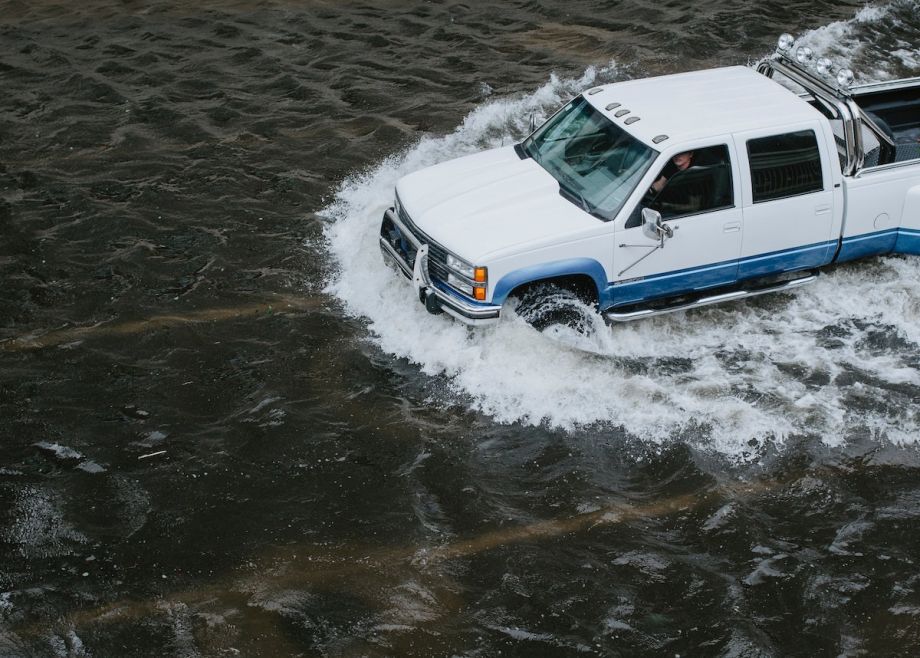
_600_350_80_s_c1.jpg)



